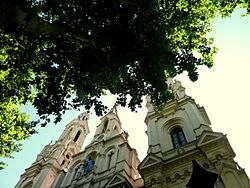Barracas, Buenos Aires
| Barracas | ||
|---|---|---|
| Barrio | ||

Church of Santa Felicitas
|
||
|
||
 Location of Barracas within Buenos Aires |
||
| Country |
|
|
| Autonomous City |
|
|
| Comuna | C4 | |
| Area | ||
| • Total | 7.6 km2 (2.9 sq mi) | |
| Population (2001) | ||
| • Total | 77,474 | |
| • Density | 10,000/km2 (26,000/sq mi) | |
| Time zone | ART (UTC-3) | |
| Day | December 13 | |
| Estación Buenos Aires | ||
Barracas is a barrio, or district, in the southeast part of the city of Buenos Aires, Argentina. It is located between the railroad of Ferrocarril General Manuel Belgrano and the Riachuelo River, and the streets Regimiento de Patricios, Defensa, Caseros, Vélez Sársfield, Amancio Alcorta, Lafayette, and Lavardén. The name Barracas comes from the word barraca, which refers to a temporary construction of houses using rudimentary materials.
In the 18th century, "Barracas" began to grow on the banks of the Riachuelo River, becoming a slave quarter, as well as an area for leather tanneries, and abbatoirs.
On March 24, 1791, a bridge was built that gave the neighborhood an important strategic value during the British invasions of the Río de la Plata. In 1858, part of this bridge was destroyed by flood and was replaced by a new iron bridge in 1871. There were a series of problems with this new bridge until the inauguration of its replacement in 1931 that still stands today.
Throughout most of the 19th century, the neighbourhood was home to some of the wealthiest families of the city. Santa Lucía avenue was the principal centre of activity and contained many of the city's most famous stores at the time. However, an 1871 yellow fever epidemic that swept through many southern parts of the city forced most wealthy families and the area's middle class to relocate to the north of the city, leaving the neighbourhood to become the working-class area that it remains today.
A number of wealthy Argentine families retained properties in Barracas during much of the 20th century, maintaining them as rental units of varying quality. Immigrants, especially Italians, started to settle here and it became popular with the working-class. Modest cafés were opened, attracting people with a lower financial status. Factories dominated the economy of the area up until around 1980, although they continue to provide an important source of employment.
...
Wikipedia

